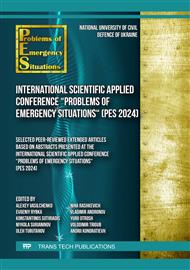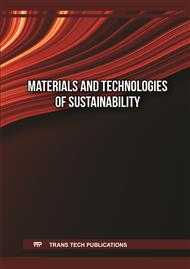[1]
Chernukha, A., Teslenko, A., Kovaliov, P., Bezuglov, O. (2020). Mathematical modeling of fire-proof efficiency of coatings based on silicate composition (2020) Materials Science Forum, 1006 MSF, 70-75.
DOI: 10.4028/www.scientific.net/msf.1006.70
Google Scholar
[2]
Pospelov, B., Rybka, E., Meleshchenko, R., Gornostal, S., Shcherbak, S. (2017). Results of experimental research into correlations between hazardous factors of ignition of materials in premises. Eastern-European Journal of Enterprise Technologies, 6/10 (90), 50–56.
DOI: 10.15587/1729-4061.2017.117789
Google Scholar
[3]
S. Park, Y. Han, D.W. Son, (2020). Flame retardancy of wood products by spreading concentration and impregnation time of flame retardant, Journal of the Korean Wood Science and Technology, 48(4), 417–430.
DOI: 10.5658/wood.2020.48.4.417
Google Scholar
[4]
P. Mali, N. Sonawane, V. Patil, G.P. Lokhande, R. Mawale, N.S. Pawar, (2021). Morphology of wood degradation and flame retardants wood coating technology: an overview, International Wood Products Journal, 13(1), 21–40.
DOI: 10.1080/20426445.2021.2011552
Google Scholar
[5]
Chernukha, A., Chernukha, A., Kovalov, P., Savchenko, A. (2021). Thermodynamic study of fire-protective material Materials Science Forum, 1038 MSF, 486–491.
DOI: 10.4028/www.scientific.net/msf.1038.486
Google Scholar
[6]
Zmaha, M., Pozdieiev, S., Zmaha, Y., Nekora, O., Sidnei, S. (2021). Research of the behavioral of the wooden beams with fire protection lining under fire loading IOP Conference Series: Materials Science and Engineering, 1021/1, 012031.
DOI: 10.1088/1757-899x/1021/1/012031
Google Scholar
[7]
Dubinin D., Korytchenko K., Lisnyak A., Hrytsyna I., Trigub V. (2018). Improving the installation for fire extinguishing with finelydispersed water. Eastern-European Journal of Enterprise Technologies, 2/10 (92), 38–43.
DOI: 10.15587/1729-4061.2018.127865
Google Scholar
[8]
Medved, I., Otrosh, Y., Kovalov, A., Mykhailovska, Y. (2023). Search for solutions in the problems of calculation of building structures.AIP Conference Proceedings, 2840(1), 040003.
DOI: 10.1063/5.0168054
Google Scholar
[9]
Pospelov, B., Rybka, E., Meleshchenko, R., Gornostal, S., Shcherbak, S. (2017). Results of experimental research into correlations between hazardous factors of ignition of materials in premises. Eastern-European Journal of Enterprise Technologies, 6/10 (90), 50–56.
DOI: 10.15587/1729-4061.2017.117789
Google Scholar
[10]
Pospelov,B., Andronov, V., Rybka, E., Krainiukov, O., Karpets, K., Pirohov, O., Semenyshyna, I., Kapitan, R., Promska, A., Horbov, O. (2019). Development of the correlation method for operative detection of recurrent states Eastern-European Journal of Enterprise Technologies, 6/4 (102), 39–46.
DOI: 10.15587/1729-4061.2019.187252
Google Scholar
[11]
Pospelov, B., Andronov, V., Rybka, E., Popov, V., Romin, A. (2018). Experimental study of the fluctuations of gas medium parameters as early signs of fire. Eastern-European Journal of Enterprise Technologies, 1/10 (91), 50–55.
DOI: 10.15587/1729-4061.2018.122419
Google Scholar
[12]
Sadkovyi, V., Andronov, V., Semkiv, O., Kovalov, A., Rybka, E., Otrosh, Y., Udianskyi, M., Koloskov, V., Danilin, A., Kovalov, P. (2021). Fire resistance of reinforced concrete and steel structures. Fire resistance of reinforced concrete and steel structures, 1-166.
DOI: 10.15587/978-617-7319-43-5
Google Scholar
[13]
Myrgorod, O., Shabanova, G., Ruban, A., & Shvedun, V. (2021). Experiment Planning for Prospective Use of Barium-Containing Alumina Cement for Refractory Concrete Making. In Materials Science Forum, 1038, p.330–335.
DOI: 10.4028/www.scientific.net/msf.1038.330
Google Scholar
[14]
Kovalov, A., Otrosh, Yu., Surianinov, M., Kovalevska, T. (2019). Experimental and computer researches of ferroconcrete floor slabs at high-temperature influences. Materials Science Forum, 968 MSF, 361–367.
DOI: 10.4028/www.scientific.net/msf.968.361
Google Scholar
[15]
Vasilchenko, A., Danilin, O., Lutsenko, T., & Ruban, A. (2021). Features of Evaluation of Fire Resistance of Reinforced Concrete Ribbed Slab under Combined Effect "Explosion-Fire." In Materials Science Forum, 1038, p.492–499.
DOI: 10.4028/www.scientific.net/msf.1038.492
Google Scholar
[16]
Kovalov, A., Otrosh, Y., Ostroverkh, O., Hrushovinchuk, O., Savchenko, O. (2018). Fire resistance evaluation of reinforced concrete floors with fire-retardant coating by calculation and experimental method. E3S Web of Conferences, 60, № 00003.
DOI: 10.1051/e3sconf/20186000003
Google Scholar
[17]
Vasilchenko, A., Danilin, O., Lutsenko, T., Ruban, A., & Nestorenko, D.(2020). Features of some Polymer Building Materials Behavior at Heating. Materials Science Forum, 1006, 47-54.
DOI: 10.4028/www.scientific.net/msf.1006.47
Google Scholar
[18]
D. Tregubov, O. Tarakhno, V. Deineka, F. Trehubova. (2022). Oscillation and Stepwise of Hydrocarbon Melting Temperatures as a Marker of their Cluster Structure Solid State Phenomena, 334, p.124–130.
DOI: 10.4028/p-3751s3
Google Scholar
[19]
Y. Hapon, D. Tregubov, O. Tarakhno, V. Deineka. (2020). Technology оf safe galvanochemical process оf strong platings forming using ternary alloy Materials Science Forum, 1006 MSF, p.233–238.
DOI: 10.4028/www.scientific.net/msf.1006.233
Google Scholar
[20]
A. Chernukha, A. Chernukha, K. Ostapov, T. Kurska, (2021). Investigation of the processes of formation of a fire retardant coating, Materials Science Forum, 1038, 480–485.
DOI: 10.4028/www.scientific.net/msf.1038.480
Google Scholar
[21]
B. Pospelov, V. Andronov, E. Rybka, K. Karpets, E. Kochanov, (2021). Development of the Method of Operational Forecasting of Fire in the Premises of Objects Under Real Conditions Eastern-European Journal of Enterprise Technologies. 2/10, (110), 43–50.
DOI: 10.15587/1729-4061.2021.226692
Google Scholar
[22]
Blyznyuk, O., Vasilchenko, A., Ruban, A., & Bezuhla, Y. (2020). Improvement of Fire Resistance of Polymeric Materials at their Filling with Aluminosilicates. In Materials Science Forum, 1006, p.55–61.
DOI: 10.4028/www.scientific.net/msf.1006.55
Google Scholar
[23]
I. Van Der Veen, J. De Boer, (2012). Phosphorus flame retardants: Properties, production, environmental occurrence, toxicity and analysis, Chemosphere. 88(10), 1119–1153.
DOI: 10.1016/j.chemosphere.2012.03.067
Google Scholar
[24]
S.K. Witchey, V. Sutherland, B. Collins, G. Roberts, K.R. Shockley, M. Vallant, J. Krause, H. Cunny, S. Waidyanatha, E. Mylchreest, B. Sparrow, R.A. Moyer, M. Behl, (2023). Reproductive and developmental toxicity following exposure to organophosphate ester flame retardants and plasticizers, triphenyl phosphate and isopropylated phenyl phosphate, in Sprague Dawley rats, Toxicological Sciences. 191(2), 374–386.
DOI: 10.1093/toxsci/kfac135
Google Scholar
[25]
K. Kademoglou, F. Xu, J. A. Sánchez, L. S. Haug, A. Covaci, C. Collins, (2017). Legacy and alternative flame retardants in Norwegian and UK indoor environment: Implications of human exposure via dust ingestion, Environment International. 102, 48–56.
DOI: 10.1016/j.envint.2016.12.012
Google Scholar
[26]
N. R. Maddela, K. Venkateswarlu, M. Megharaj, (2020). Tris(2-chloroethyl) phosphate, a pervasive flame retardant: critical perspective on its emissions into the environment and human toxicity, Environmental Science: Processes & Impacts. 22(9), 1809–1827.
DOI: 10.1039/d0em00222d
Google Scholar
[27]
C. He, C. Lin, J.F. Mueller, (2020). Organophosphate flame retardants in the environment: Source, occurrence, and human exposure, In Comprehensive Analytical Chemistry. 88, 341–365.
DOI: 10.1016/bs.coac.2019.10.008
Google Scholar
[28]
C. Yao, H. Yang, Y. Li, (2021). A review on organophosphate flame retardants in the environment: Occurrence, accumulation, metabolism and toxicity, Science of the Total Environment. 795, 148837.
DOI: 10.1016/j.scitotenv.2021.148837
Google Scholar
[29]
A. Blum, M. Behl, L.S. Birnbaum, M.L. Diamond, A.L. Phillips, V. Singla, N.S. Sipes, H.M. Stapleton, M. Venier, (2019). Organophosphate ester flame retardants: Are they a regrettable substitution for polybrominated diphenyl ethers, Environmental Science and Technology Letters. 6(11), 638–649.
DOI: 10.1021/acs.estlett.9b00582
Google Scholar
[30]
A.K. Rosenmai, S.B. Winge, M. Möller, J. Lundqvist, E.B. Wedebye, N.G. Nikolov, H.K.L. Johansson, A.M. Vinggaard, (2021). Organophosphate ester flame retardants have antiandrogenic potential and affect other endocrine related endpoints in vitro and in silico, Chemosphere, 263, 127703.
DOI: 10.1016/j.chemosphere.2020.127703
Google Scholar
[31]
B. Pospelov, E. Rybka, R. Meleshchenko, O. Krainiukov, S. Harbuz, Yu. Bezuhla, I. Morozov, A. Kuruch, O. Saliyenko, R. Vasylchenko, (2020). Use of uncertainty function for identification of hazardous states of atmospheric pollution vector, Eastern-European Journal of Enterprise. 2/10, (104), 6–12.
DOI: 10.15587/1729-4061.2020.200140
Google Scholar
[32]
V. Sadkovyi, B. Pospelov, V. Andronov, E. Rybka, O. Krainiukov, А. Rud, K. Karpets, Yu. Bezuhla, (2020). Construction of a method for detecting arbitrary hazard pollutants in the atmospheric air based on the structural function of the current pollutant concentrations, Eastern-European Journal of Enterprise. 6/10, (108), 14–22.
DOI: 10.15587/1729-4061.2020.218714
Google Scholar
[33]
Pasternak, V., Ruban, A., Surianinov, M., Otrosh, Y., & Romin, A. (2022). Software Modeling Environment for Solving Problems of Structurally Inhomogeneous Materials. In Materials Science Forum, 1068, p.215–222.
DOI: 10.4028/p-h1c2rp
Google Scholar
[34]
O. Skorodumova, O. Tarakhno, O. Chebotaryova, O. Bezuglov, F.M. Emen, (2021). The use of sol-gel method for obtaining fire-resistant elastic coatings on cotton fabrics, Materials Science Forum, 1038, 468–479.
DOI: 10.4028/www.scientific.net/msf.1038.468
Google Scholar
[35]
O. Skorodumova, O. Tarakhno, O. Chebotaryova, (2022). Improving the Fire-Retardant Properties of Cotton-Containing Textile Materials through the Use of Organo-Inorganic SiO2 Sols, Key Engineering Materials, 927, 63–68.
DOI: 10.4028/p-jbv49r
Google Scholar
[36]
O. Zybina, M. Gravit, Intumescent coatings for fire protection of building structures and materials, Springer series on polymer and composite materials (2020).
DOI: 10.1007/978-3-030-59422-0
Google Scholar
[37]
Z. Jiang, H. Li, Y. He, Y. Liu, C. Dong, Flame retardancy and thermal behavior of cotton fabrics based on a novel phosphorus-containing siloxane, Applied Surface Science. 479 (2019) 765–775.
DOI: 10.1016/j.apsusc.2019.02.159
Google Scholar
[38]
X. Cheng, C. Liang, J. Guan, X. Yang, R. Tang, Flame retardant and hydrophobic properties of novel sol-gel derived phytic acid/silica hybrid organic-inorganic coatings for silk fabric, Applied Surface Science. 427 (2018) 69–80.
DOI: 10.1016/j.apsusc.2017.08.021
Google Scholar
[39]
T. Leber, D. Kenn, F. Matt, M. Scheller, T. Tonnesen, J. González, Julián, Phosphate-bonded refractories in hydrogen containing atmosphere, Open Ceramics. 17 (2024) 100511.
DOI: 10.1016/j.oceram.2023.100511
Google Scholar
[40]
Pasternak, V., Samchuk, L., Huliieva, N., Andrushchak, I., & Ruban, A. (2021). Investigation of the Properties of Powder Materials Using Computer Modeling. Materials Science Forum, 1038, 33–39.
DOI: 10.4028/www.scientific.net/msf.1038.33
Google Scholar
[41]
Ruban, A., Pasternak, V., & Huliieva, N. (2022). Prediction of the Structural Properties of Powder Materials by 3D Modeling Methods. In Materials Science Forum, 1068, p.231–238.
DOI: 10.4028/p-18k386
Google Scholar
[42]
О. Skorodumova, O. Tarakhno, A.M. Babayev, A. Chernukha, S. Shvydka, Study of Phosphorus-Containing silica coatings based on liquid glass for fire protection of textile materials, Key Engineering Materials. 954 (2023) 167–175.
DOI: 10.4028/p-hgyq9v
Google Scholar
[43]
M. Zhao, X. Zou, Q. Wei, S. Meng, H. B. Zhang, C. Su, Preparation and Characterization of Na2O-Y2O3-P2O5-SiO2 Transparent Glass Ceramics, Solid State Phenomena. 281 (2018) 692–698.
Google Scholar
[44]
M. Zribi, S. Baklouti, Investigation of Phosphate based geopolymers formation mechanism. Journal of Non-Crystalline Solids. 562 (2021) 120777.
DOI: 10.1016/j.jnoncrysol.2021.120777
Google Scholar
[45]
S. Bellayer, M. Jimenez, B. Prieur, B. Dewailly, A. Ramgobin, J. Sarazin, B. Revel, G. Tricot, S. Bourbigot, Fire retardant sol-gel coated polyurethane foam: Mechanism of action, Polymer Degradation and Stability. 147 (2018) 159–167.
DOI: 10.1016/j.polymdegradstab.2017.12.005
Google Scholar
[46]
R. Karan, P. Pal, P. Maiti, K. Das, Structure, properties and in-vitro response of SiO2-Na2O-CaO-P2O5 system, based glass-ceramics after partial replacement of Na2O by Li2O, Journal of Non-Crystalline Solids. 556 (2021) 120554.
DOI: 10.1016/j.jnoncrysol.2020.120554
Google Scholar
[47]
A. Stýskalík, D. Škoda, Z. Moravec, M. Babiak, C. E. Barnes, J. Pinkas, Control of micro/mesoporosity in non-hydrolytic hybrid silicophosphate xerogels. Journal of Materials Chemistry. A, Materials for Energy and Sustainability. 3(14) (2015) 7477–7487.
DOI: 10.1039/c4ta06823h
Google Scholar
[48]
O.B. Skorodumova, G.D. Semchenko, Y.N. Goncharenko, V.S. Тolstoi, Crystallization of SiO2 from ethylsilicate-based gels, Glass and Ceramics. 58(1–2) (2001) 31–33.
DOI: 10.1023/a:1010933028152
Google Scholar
[49]
M. Abbasi, B. Hashemi, Fabrication and characterization of bioactive glass-ceramic using soda–lime–silica waste glass. Materials Science and Engineering: 37 (2014) 399–404.
DOI: 10.1016/j.msec.2014.01.031
Google Scholar
[50]
N.F.B. Pallan, Х.А. Matori, M. Hashim, R.S. Azis, N. Zainuddin, F.M. Idris, I.R. Ibrahim, L.C. Wah, S.N.A. Rusly, N. Adnin, M.Z.A. Khiri, Z.N. Alassan, N. Mohamed, Effects of different sintering temperatures on thermal, physical, and morphological of SiO2-Na2O-CaO-P2O5 based glass-ceramic system from vitreous and ceramic wastes, Science of Sintering. 51(4) (2019) 377–387.
DOI: 10.2298/sos1904377p
Google Scholar



